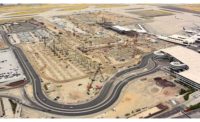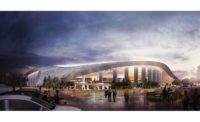Local economies are booming in both Seattle and Portland, and construction is playing a big role. Taking advantage of the good economic news in the Pacific Northwest is one of the region’s most established companies, 130-year-old construction firm Lease Crutcher Lewis.
Headquartered in Seattle, the company, with nearly $500 million a year in revenue, employs around 600 people in Washington and Oregon. In the past three years, it has completed numerous signature projects, including the 19-story Nine Two Nine office tower in Bellevue, Wash.; the Discovery Hall STEM building at the University of Washington at Bothell; the Elephant Lands habitat at the Portland Zoo; and the 654-unit Via6 apartment complex in Seattle.
Much of the economic activity—and resultant new construction in Seattle—is being fueled by the tech sector, says Gary Smith, Seattle president of Lewis. In addition to longtime regional anchor Boeing, companies such as Amazon, Google and Facebook are expanding or relocating offices into the area.
Lewis has built or renovated approximately 1.5 million sq ft for Amazon over the last six years as well as dozens of projects ranging from office buildings to production plants for Boeing. The company has also recently built local facilities for Silicon Valley stalwarts Apple and Oracle, among other tech firms.
Lewis CEO Bart Ricketts believes technology companies are clustering in Seattle for two reasons: proximity to talent and housing prices that are significantly lower than in the San Francisco Bay area, the traditional center of the tech industry. In a similar vein, Ricketts notes, shoe and apparel companies are gathering in the Portland area to be close to Nike and its main rival, Adidas.
In Washington, Lewis tends to focus on private-sector work, but the company’s clients in Oregon are often institutional entities, including the Oregon Zoo and the University of Oregon and Oregon State University. That’s by design, says Ricketts. Diversifying in this way spreads risk over different market sectors and the economic cycles of both states.
“I think that the two cities [Seattle and Portland], even though they share a lot of the same market characteristics, they’re slightly countercyclical,” he says. “And it seems that when recession comes, Seattle tends to slide into the recession earlier than Portland does, and Portland recovers slower than Seattle. So those two factors seem to help us balance the work when there is a recession coming and a recovery gets underway.
“It seems to have tracked fairly closely that way for the last three recessions,” Ricketts adds. “I’m not sure if that’s going to hold true in the future, but that has been something that helped us ride out this last recession, when Portland had a good, stable, steady backlog of work and Seattle was really on a steep downturn. So it’s nice to be a regional contractor and have that playing in your favor.”
Smith says, “I think the key way we try to deal with [cyclicality] is the notion of diversification, and spreading our work portfolio over various markets where each one of those has a little bit different cyclical timing than maybe the overall market in average,” he says. “The higher-education market, for example, which has been active in the past, is a little bit slow right now. We expect it’s going to pick up again in the future, and so not ignoring that during this period of busyness is a key strategy for us.”
Repeat Business
Smith and Ricketts estimate that 90% of the firm’s business comes from repeat clients, and during slow times Lewis maintains contact with them, whether they be state universities or private developers. They talk about potential plans, discuss the economics of possible projects and generally stay in touch so, as Smith says, “when some other market slows down and that one picks up, we’re in a position to capture our share of work.”
The overwhelming volume of repeat business reflects the importance the company places on relationships and value-based projects, rather than attempting to outbid competitors.
Says Lewis project manager Kathryn Emtman, who supervised construction of the Nine Two Nine office high-rise, built for developer Trammell Crow: “We see ourselves as more of a high-value contractor that works with the owner to get them what they want in the most cost-effective manner possible.”
That rings true with Matt Rosauer, principal of the Pine Street Group, which developed Via6 in Seattle. Rosauer, who worked for Lewis for nine years before becoming a developer, says, “They’re very focused on the client care side of things. They focus on the relationships and on maintaining relationships because an important part of their business is doing repeat work. So they look to do the right thing, whether they need to or not.”
Rosauer adds, “They’re locally owned, they have a great brand, they attract top talent and they grow from within. With the smart people who come up through the ranks, they have dynamic people at all levels, and they’re the type of people who can sit in an owner’s meeting and then go to a field meeting and be impressive on both fronts.”
The firm takes a collaborative approach with subcontractors and clients, which have included the University of Washington. The university sought just such an approach when it contracted with Lewis for its Discovery Hall project, which opened in 2014.
Steve Tatge, the project manager and now executive director of major capital projects for UW, calls working with Lewis “a refreshing and eye-opening experience,” and adds that his measures for the company’s job performance were “off the charts.”
“They’re honest people,” says David Allen, executive vice president of Seattle-based McKinstry, a major mechanical and electrical construction service provider that has worked with Lewis for five-and-a-half decades. “They’re always straightforward, and they’re a company that doesn’t have a bunch of side agendas going …. They’re fairly open-book with everyone, and they’re able to have difficult discussions that bring issues to the table instead of letting them fester. They are interested in us as a company, [and] they are concerned with the subcontractors they work with, that we’re all doing well …. They’re pretty good at letting us know what the customer expects from them, so we can understand where the whole team needs to go and what the client’s expected outcomes are.”
“They’re very well organized,” adds Jeff Thiede, president and CEO of MDU Construction Services Group, parent of On Electric Group in Portland. “They listen to the subcontractors, and they do what they can, in the best interests of the owner, to respond timely and get us the information we need so we can make the whole project successful.”
Getting clients what they need often goes beyond technical building issues, says Janice Westcott, marketing director of Lewis’ Portland office. By design, a new education department building the company was constructing at the University of Oregon took over a community garden on the campus. When the relocated garden was opened, Tanner Perrine, project engineer at Lewis, went to a local nursery and bought tomato plants that he put in the new plot.
“That wasn’t a construction challenge that needed to be solved,” says Westcott, “but it demonstrated that we understood what was important to them. It’s a small story, but I think it speaks to what’s different about how we approach working with our clients.”
- 2015 job growth in Portland ranked third in the country at 3.8%, putting the region in a league with Silicon Valley and Austin, Texas.
- Seattle has a 3.9% unemployment rate vs. 5% nationally. Construction is a key driver of jobs in the area.
Source: U.S. Bureau of Labor Statistics and Seattle Times








Post a comment to this article
Report Abusive Comment